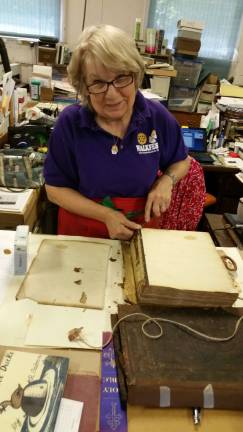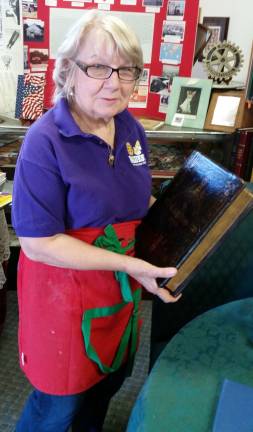Turul Bookbindery bound for success


JEFFERSON — There was a time not so long ago when words weren’t just masses of pixels on a screen. The printed word holds an important place in history, and businesses like Turul Bookbindery, on Route 15 South in Jefferson, are making sure that this history is preserved.
Turul Bookbindery restores and rebinds books printed from the late 1700s onward, in addition to their ongoing work binding vault editions and annual collections of numerous prestigious journals and newspapers. Turul understands the importance of history, having been around for 83 years itself.
“My father started this business in Sopron, Hungary, northwest of Budapest,” says Margit Rahill, current owner of Turul, along with her husband, Mike, and son, Michael. As her expert hands carefully remove the cracked leather cover of an ancient family bible, Rahill speaks about the company’s history and her father, Louis Gregorencsics, who founded the company in 1932.
Like her son Michael, Margit grew up in the bindery. She retains some childhood memories of the days when the shop was still in Hungary. That phase ended in 1956 with the Hungarian Uprising. The family emigrated to the United States and the business was restarted in Astoria, Queens, where it remained until 1975, when the decision was made to move once again, to Jefferson.
“My brother’s kids were going to Junior High at that time,” Rahill said. “He wanted them to live in the country.”
The family continued to grow with the business.
“Now we have the third generation in the bindery, and even the fourth generation is learning it," she said.
Although her grandchildren are only 5 and 7 years old, one gets the impression that Turul may well continue under their guidance.
As can be imagined, things haven’t always gone smoothly for Turul in its 83 years.
“Bookbinding is a tough business,” says Rahill. “It’s not a necessity. It’s also hard to find experienced outside help,” and the necessary training is extensive. In fact, very few real competitors remain in the industry, perhaps a few hundred across the country.
“There are lots of binders,” says Rahill, “But most are just stitching and stapling, or magazine binding. The hand restoration is a rare specialty, and most of the company’s equipment for this art is antiques built between the 1930s and the 1960s.
Rahill plans to expand the company’s private restoration work in the future, but is keeping her feet on the ground.
“I don’t want to build big,” she says. Asked what advice she would offer to other small businesses, she says, “Stay with it as long as you can. Every minute is worth it."